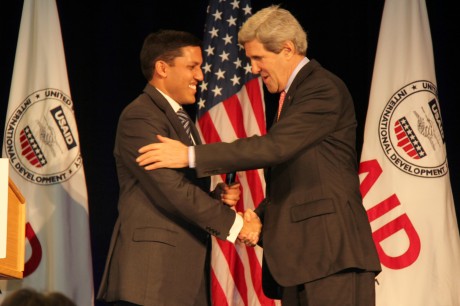This morning, USAID hosted Secretary of State John Kerry for his first visit with USAID staff at the Ronald Reagan Building. Denise Rollins, Senior Deputy Assistant Administrator for Asia, delivered opening remarks recounting some of the successes we have seen since the Agency’s inception by former President John F. Kennedy. With a warm welcome, Administrator Shah introduced Secretary Kerry to the assembly, commended him for his long history as an ally for development, and passed to him the “mantle of development” in his new role at the U.S. Department of State.

Administrator Rajiv Shah welcomes Secretary of State John Kerry to USAID. Photo credit: Pat Adams, USAID
Secretary Kerry discussed the importance of development in the current global landscape, making note that the most important work we do is provide linkages between multiple initiatives that “make a difference in the lives of other people,” citing USAID priorities such as education, global health and HIV prevention programs, ending extreme poverty, and gender equality.
A long friend to development, Secretary Kerry spent twenty-eight years on the Senate Foreign Relations Committee, where he played a principle role in authoring and passing major legislation on humanitarian aid, international criminal practices, and climate change.
Secretary Kerry has also helped integrate development into the U.S. foreign and national security policy, and this morning, reminded us how development directly impacts us at home as much as it impacts the people we assist overseas. Through jobs, investments and partnerships with organizations committed to improving lives of those with limited resources, we all do “some of the most important work in the world.” As Secretary Kerry told the assembly, “we present the face of America [and] the values of America” and it is our job to “change opinions, to save lives…[and] to connect the dots so Americans understand [development] isn’t a waste of effort.”
As tokens of a partnership for development, Administrator Shah gave Secretary Kerry innovative tools from the Massachusetts Institute of Technology’s (MIT) Development Lab – a cell phone charger that runs off the power of a bicycle and a corn sheller (PDF) that frees women and children from backbreaking work shelling by hand. MIT is a member of USAID’s Higher Education Solutions Network, and leads the International Development Innovation Network, which fosters local innovation by supporting the ingenuity, creativity and resilience of people living in poverty.
USAID shares Secretary Kerry’s vision for development and look forward to working with him to help build a world where people everywhere have access to a better life.
As Secretary Kerry said, “We [all] advance because we engage and show we care about more than just ourselves.”
Read the full transcript of Secretary Kerry’s address to USAID.









